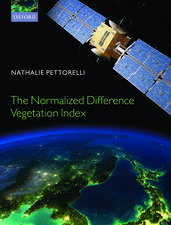Indian Pandanaceae - an overview
Autor Altafhusain Nadaf, Rahul Zananen Limba Engleză Hardback – mar 2013
In recent years, a chloroplast DNA-based molecular phylogenetic approach has been followed to understand the evolutionary relationship among the plant species. The interrelationship among the 14 Pandanus species at infrageneric level has been worked out using this approach, which has led to the rearrangement of some species to the subgenera proposed by Stone (1974). Moreover, the close relationship between Pandanus and Benstonea has been confirmed and the interrelationship of Indian Pandanus genus in global context is given. This book also describes the economic importance of each Pandanus species.
| Toate formatele și edițiile | Preț | Express |
|---|---|---|
| Paperback (1) | 553.25 lei 38-45 zile | |
| Springer India – 23 aug 2016 | 553.25 lei 38-45 zile | |
| Hardback (1) | 646.62 lei 6-8 săpt. | |
| Springer India – mar 2013 | 646.62 lei 6-8 săpt. |
Preț: 646.62 lei
Preț vechi: 760.73 lei
-15% Nou
Puncte Express: 970
Preț estimativ în valută:
123.73€ • 129.18$ • 102.40£
123.73€ • 129.18$ • 102.40£
Carte tipărită la comandă
Livrare economică 04-18 aprilie
Preluare comenzi: 021 569.72.76
Specificații
ISBN-13: 9788132207528
ISBN-10: 8132207521
Pagini: 120
Ilustrații: XV, 163 p.
Dimensiuni: 178 x 254 x 17 mm
Greutate: 0.59 kg
Ediția:2012
Editura: Springer India
Colecția Springer
Locul publicării:New Delhi, India
ISBN-10: 8132207521
Pagini: 120
Ilustrații: XV, 163 p.
Dimensiuni: 178 x 254 x 17 mm
Greutate: 0.59 kg
Ediția:2012
Editura: Springer India
Colecția Springer
Locul publicării:New Delhi, India
Public țintă
ResearchCuprins
Dedication.- Preface.- Acknowledgements.- Chapter 1 World Pandanaceae: An overview.- Chapter 2 Indian Pandanaceae: Present Status and Need of Revision.- Chapter 3 Biogeography of Indian Pandanaceae.- Chapter 4 Morphology of Indian Pandanaceae.- Chapter 5 Species Identification Key for Indian Pandanaceae.- Chapter 6 Phylogenetic Relationship among the Indian Pandanus Species.- Chapter 7 Economical Importance of Indian Pandanus species.- Chapter 8 Conservation of Indian Pandanaceae: Current Status and Need.- Glossary.- Index.
Recenzii
From the book reviews:
“The authors have visited the whole sub-continent to collect, study and understand the species in the field and reported their results in the eight chapters of this book. … the results presented in this monumental and much-needed work will serve people with a broad spectrum of interests and will stimulate future research and interest in this economically important family in India.” (S. Buerki and M. W. Callmander, Kew Bulletin, Vol. 69, 2014)
“The authors have visited the whole sub-continent to collect, study and understand the species in the field and reported their results in the eight chapters of this book. … the results presented in this monumental and much-needed work will serve people with a broad spectrum of interests and will stimulate future research and interest in this economically important family in India.” (S. Buerki and M. W. Callmander, Kew Bulletin, Vol. 69, 2014)
Notă biografică
1. Dr. Altafhusain Nadaf is a Senior Assistant Professor at the Department of Botany, University of Pune, Pune; working in the area of biochemistry and molecular genetics of Indian Pandanaceae for past 10 years. He was awarded DST-BOYSCAST Fellowship to work as a Visiting Fellow at Centre for Plant Conservation Genetics, Southern Cross University, Lismore, Australia for one year in 2010-11. He has received research grants by several funding agencies including DST-Fast Track Scheme for Young Scientists and DBT-Rapid grant for Young Investigators (RGYI). He has successfully guided several Ph. D. and M. Phil. Students and women scientists (under DST-Women Scientists Scheme -A & B). He is working as a reviewer for many International journals. He has in his credit more than 40 research papers published in peer reviewed national and international journals of repute. He has presented his research work at national and international level. 2. Dr. Rahul Zanan is a young researcher working on the taxonomy and phylogeny of Indian Pandanaceae for past 5 years. He has obtained his doctoral degree from University of Pune, Pune. He has published 8 research papers in International journals. He is the authority on 3 new Pandanus species of India. He has received several awards for best oral and poster presentations in International and National conferences.
Textul de pe ultima copertă
Indian screw pine family Pandanaceae represents three genera, in which genus Pandanus and Benstonea are distributed in two hotspots in India – the Western Ghats and the Northeast Himalayan region. For the fi rst time, Indian Pandanaceae has been assessed for its taxonomic status and phylogenetic relationship. The extensive survey by the authors led to the discovery of three new Pandanus species (two from the Western Ghats and one from the Northeast Himalaya). The present taxonomic revision con fi rmed total number of Pandanus species to 14 that are distributed in the Southern India
(9 species) and Northeast Himalayan region (5 species). Genus Benstonea is represented by two species, one from Southern India and another species common to both regions. A detailed species identi fi cation key is given along with conservation status of each species following IUCN Red List Categories and Criteria (2001). The study revealed that, out of 16 Pandanus and Benstonea species, six species are under threatened categories.
In recent years, a chloroplast DNA-based molecular phylogenetic approach has been followed to understand the evolutionary relationship among the plant species. The interrelationship among the 14 Pandanus species at infrageneric level has been worked out using this approach, which has led to the rearrangement of some species to the subgenera proposed by Stone (1974). Moreover, the close relationship between Pandanus and Benstonea has been confi rmed and the interrelationship of Indian Pandanus genus in global context is given. This book also describes the economic importance of each Pandanus species.
(9 species) and Northeast Himalayan region (5 species). Genus Benstonea is represented by two species, one from Southern India and another species common to both regions. A detailed species identi fi cation key is given along with conservation status of each species following IUCN Red List Categories and Criteria (2001). The study revealed that, out of 16 Pandanus and Benstonea species, six species are under threatened categories.
In recent years, a chloroplast DNA-based molecular phylogenetic approach has been followed to understand the evolutionary relationship among the plant species. The interrelationship among the 14 Pandanus species at infrageneric level has been worked out using this approach, which has led to the rearrangement of some species to the subgenera proposed by Stone (1974). Moreover, the close relationship between Pandanus and Benstonea has been confi rmed and the interrelationship of Indian Pandanus genus in global context is given. This book also describes the economic importance of each Pandanus species.
Caracteristici
The species key, and coloured photographs and illustrations are used for quick and reliable identification of Pandanus species The most recent morphological and cpDNA sequences are used to describe the phylogenetic relationship among Pandanus species IUCN Red List Criteria for the conservation of Indian Pandanus species are described in detail A comparative account of the various species world over is also presented












